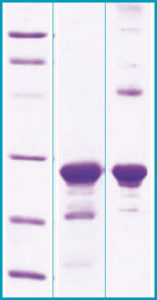Angiopoietin-Like Protein 4 Human E. coli
Angiopoietin-like protein 4 (ANGPTL4) is a secreted 50 kD protein that modulates the disposition of circulating triglycerides (TG) by inhibiting lipoprotein lipase (LPL). ANGPTL4 was identified as a gene that is induced by fasting, and during 3T3-L1 preadipocyte differentiation, and was thus named HFARP (hepatic fibrinogen/angiopoietin-related protein), FIAF (fasting-induced adipose factor), and PGAR (PPAR-angiopoietin related). It is one of the seven members of the angiopoietin-like family. Angptl4 is expressed ubiquitously, predominantly in adipose tissue, liver, placenta, myocardium, keratinocytes, podocytes, intestine, and pituitary gland. ANGPTL4 is a fusion protein consisting of an N-terminal coiled-coil domain and a C-terminal fibrinogen-like domain. These two domains have been shown to have distinct biological functions. The N-terminal domain is responsible for the inhibitory effects on LPL, converting the active form of LPL into an inactive form, and the C-terminus mediates its antiangiogenic functions. Interestingly, these two domains are separated by a short linker that can be cleaved after secretion. Upon secretion into the circulation, ANGPTL4 is cleaved into an N-terminal domain and a C-terminal fibrinogen-like domain. The N-terminal peptide circulates as an oligomer, and the fibrinogen-like domain circulates as a monomer. The N-terminal domain of ANGPTL4 interacts directly but transiently with LPL, triggering a stable conformational switch in LPL that irreversibly inactivates the enzyme. Cleavage of ANGPTL4 appears to be tissue-dependent in humans; liver secretes cleaved ANGPTL4, whereas adipose tissue secretes the full-length form. In mice the full-length form of ANGPTL4 is physically associated with HDL, whereas truncated ANGPTL4 is associated with low density lipoprotein. In humans, both full-length and truncated ANGPTL4 are associated with HDL. ANGPTL4 expression is upreguated by fasting, free fatty acids, PARR agonists, acute phase response, glucocorticoids, and downregulated by insulin. ANGPTL4 has been implicated in a variety of diseases, including cardiovascular disease, cancer metastasis, obesity, diabetes, wound repair, inflammation, arthritis and nephrotic syndrome. Serum or plasma levels were determined in a limited number of studies. ANGPTL4 serum levels display high variability between individuals ranging from 2 to 158 ng/ml. In post-heparin plasma, ANGPTL4 is increased. ANGPTL4 correlates positively with age, body fat mass, waist-hip-ratio and free faty acids but negatively with plasma high-density lipoprotein cholesterol. No correlation with triglycerides was observed in one study. ANGPTL4 is a positive acute phase protein and its increase could contribute to the hypertriglyceridemia that characteristically occurs during the acute phase response by inhibiting LPL activity.
Type
Recombinant
Description
Total 220 AA. MW: 25 kDa (calculated). UniProtKB acc.no. Q9BY76. N-Terminal His-tag, 16 extra AA (highlighted).
Source
E. coli
Purity
>95%
SDS-PAGE Gel
12% SDS-PAGE separation of Human ANGPTL4
1. M.W. marker – 14, 21, 31, 45, 66, 97 kDa
2. reduced and heated sample, 10μg/lane
3. non-reduced and non-heated sample,10μg/lane

Biological Activity
Effects of ANGPTL4 on serum levels of triglycerides, on blood glucose and on serum cholesterol levels in C57BL/6J mice.
Endotoxin
< 1.0 EU/ug
Formulation
Filtered (0.4 μm) and lyophilized from 0.5 mg/mL solution in 30 mM acetate buffer, pH 4.0
Reconstitution
Add 0.1 M acetate buffer pH 4.0 to prepare a working stock solution of 0.5 mg/mL and let the lyophilized pellet dissolve completely. For conversion into higher pH value, we recommend intensive dilution by relevant buffer to a concentration of 10 μg/mL. In higher concentrations the solubility of this antigen is limited. Filter sterilize your culture media/working solutions containing this non-sterile product before using in cell culture.
Applications
Western blotting, ELISA, Biologically active protein
Shipping
At ambient temperature. Upon receipt, store the product at the temperature recommended below.
Storage/Expiration
Store the lyophilized protein at –80 °C. Lyophilized protein remains stable until the expiry date when stored at –80 °C. Aliquot reconstituted protein to avoid repeated freezing/thawing cycles and store at –80 °C for long term storage. Reconstituted protein can be stored at 4 °C for a week.
Quality Control Test
BCA to determine quantity of the protein.
SDS PAGE to determine purity of the protein.
LAL to determine quantity of endotoxin.
– Lamounier-Zepter V, Look C, Alvarez J, Christ T, Ravens U, Schunck WH, Ehrhart-Bornstein M, Bornstein SR, Morano I. Adipocyte fatty acid-binding protein suppresses cardiomyocyte contraction: a new link between obesity and heart disease. Circ Res. 2009 Aug 14;105 (4):326-34
– Padua D, Zhang XH, Wang Q, Nadal C, Gerald WL, Gomis RR, Massague J. TGFbeta primes breast tumors for lung metastasis seeding through angiopoietin-like 4. Cell. 2008 Apr 4;133 (1):66-77

